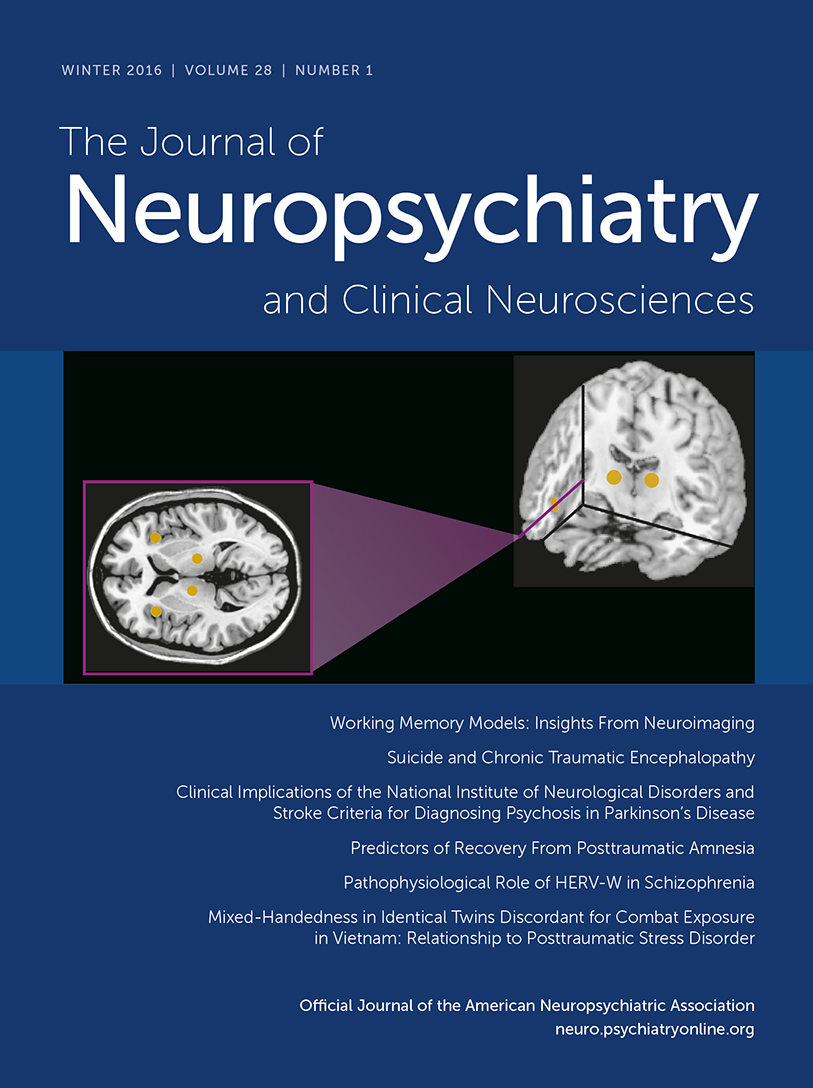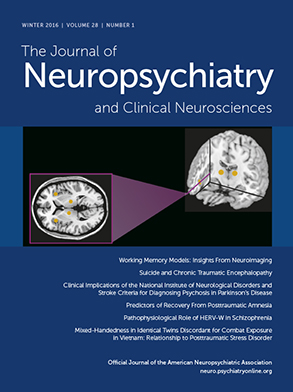To the Editor: According to the Centers for Disease Control and Prevention, 5%−20% of the US population is infected by the influenza virus annually. The influenza virus commonly affects the respiratory system, but the neuropsychiatric symptoms are often underappreciated. Karl Menninger was one of the first to link neuropsychiatric symptoms in 100 patients with influenza who were admitted with behavioral changes in 1918.
1 The famous 1918 strain of influenza was associated with von Economo’s encephalitis lethargica and postencephalitic parkinsonism.
2 In the 1960s, pediatric cases of influenza infections were associated with Reye’s syndrome.
2 The influenza A 2009 strain was coupled with an increase in the number of serious cases of acute necrotizing encephalopathy.
2 Primary neurological manifestations appear more commonly in children but can emerge in adults with symptoms of headaches, numbness, paresthesia, weakness, vertigo, decreased alertness, seizures, encephalopathy, and meningismus. Other less common neurologic complications include Guillain-Barré syndrome, aseptic meningitis, and transverse myelitis.
2,3 The influenza virus has also been associated with acute psychosis and the onset of a manic episode.
4–6 The following report illustrates a case of a patient with suspected influenza-induced mania.
Case Report
A 60-year-old man with no significant past medical or psychiatric history presented with new-onset paranoia, religious preoccupation, and mood fluctuations after a severe upper respiratory infection. The psychiatry department was consulted after the patient’s admission to the medical floor. He exhibited symptoms of mania with euphoric mood, mood lability, pressured speech, decreased need for sleep, increased energy, and flight of ideas. He had grandiose delusions of being a prophet, had “prophetic visions,” and thought he could see the future. Information from his family revealed that just before the onset of his manic symptoms the patient was suffering from an upper respiratory infection in mid-January. For 2 weeks, he exhibited myalgia, fatigue, fever, cough, insomnia, and weight loss. He did not utilize any medications, and the family started to notice concerning behavioral changes as the respiratory symptoms were improving. The patient expressed paranoia about the government. In addition, he made a grandiose list of things he wanted to accomplish in life and planned to invest lavishly in the stock market, although he had no previous interest. The patient had no previous depressive, manic, or psychotic episodes, and there was an absence of substance abuse or significant family psychiatric history. Given the unusual late presentation of mania, a thorough medical workup for acute first-onset mania and psychosis was recommended. This included a urinalysis, a urine drug screen, a urine porphobilinogen screen, a serum heavy metals screen, a serum vitamin B12 level, a serum folate level, a syphilis screen, an HIV screen, a hepatitis screen, an antinuclear antibody screen, a serum sedimentation rate, a thyroid-stimulating hormone level, an MRI scan of the head, and CT scans of the pelvis, abdomen, chest, and neck. All of these studies were within normal limits. A CSF analysis was performed and was unremarkable and negative for enterovirus, herpes simplex virus, West Nile virus, coccidioidomycosis, and Lyme disease. The patient denied ever receiving the influenza vaccine. Influenza titers were drawn, which revealed an influenza A titer of 1:16. After a very thorough medical workup, it was suspected that the patient’s mania was induced by an influenza infection. He was treated with olanzapine 20 mg/day, valproate 1500 mg/day (level of 93 μg/mL), and lorazepam for agitation and persistent insomnia. During the course of approximately 2 weeks of these medications, the patient’s symptoms improved only very slightly. He remained manic and psychotic. He was transferred to the behavioral health unit, where a cross-taper from olanzapine to risperidone 2 mg/day was initiated. Within 2 days, the patient’s mania with psychotic features resolved. He was discharged from the hospital and was encouraged to maintain his psychotropic regimen for at least 1 year.
Discussion
Late-onset bipolar I disorder and many organic etiologies of mania were considered as differential diagnoses. Bipolar and related disorder due to influenza were suspected, given the late onset of the patient’s first manic episode with no previous history of depression. This was supported by the lack of family history of bipolar I disorder and an absence of prescribed or over-the-counter medications. It was also supported because of the influenza-like symptoms immediately preceding the manic episode during the influenza season with a positive influenza A titer. The patient also adamantly denied any previous history of influenza vaccination, which might have otherwise been a confounding variable. The pathogenesis of influenza virus infection associated with the CNS remains poorly understood. It is not clear whether the influenza virus itself or the immune response to the virus is the main mechanism potentially leading to mania.
7 Influenza is potentially neurotropic and has been isolated from the CNS.
7 Maurizi
6 postulated that the direct invasion of the locus coeruleus by influenza could have resulted in a manic episode. The locus coeruleus is the principal site of norepinephrine synthesis and it has been proposed that the influenza virus may damage (Na+K)-ATPase, which is required for the normal functioning of the norepinephrine reuptake pump.
6 Therefore, should the influenza virus damage (Na+K)-ATPase, normal reuptake of norepinephrine could be decreased, possibly leading to a behavioral pattern emulating mania. In a previous case report,
6 a patient with influenza-induced mania suffered a relapse of symptoms when medications were tapered off at 6 months; therefore, we recommended that our patient continue taking the medications for at least 1 year. At that time, it may be clinically appropriate to attempt a taper with close monitoring. It is important to advance our knowledge and understanding of the potential association of influenza with mood disorders, considering the high incidence of influenza infections. Clinicians should include viral infections in their differential diagnosis when patients present with new-onset manic symptoms. Our case report adds to the sparse literature on the association of influenza with mania.

